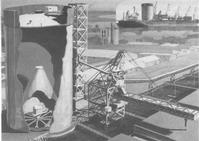


Chapter 6
I Construction During The Settlement Years
II The Use Of Timber As A Structural Material
III Structural Steel
IV Concrete Technology
V Housing
VI Industrialised Pre-cast Concrete Housing
VII Ports And Harbours
VIII Roads
IX Heavy Foundations
X Bridges
XI Sewerage
XII Water Engineering
XIII Railways
XIV Major Buildings
XV Airports
XVI Thermal Power Stations
XVII Materials Handling
i For grain:
ii For salt:
iii For sugar
iv For iron ore
v For coal
vi For bauxite:
vii For alumina:
viii For cement:
XVIII Oil Industry
XIX The Snowy Mountains Scheme
XX The Sydney Opera House
XXI The Sydney Harbour Bridge
XXII Hamersley Iron
XXIII North West Shelf
Sources and References
Index
Search
Help
Contact us

For cement:
During the last 20 years, the demand for cement in Australia has increased at a compounded rate of 6-7 per cent per annum. The largest cement silo of 30,000 tonnes capacity, is one of the largest in the world. It was built in Port Adelaide, South Australia to a design prepared by MacDonald Wagner & Priddle. It received a High Commendation Award by A.C.E.A. in 1982. With an internal diameter of 28 m and a height of 44 m the post-stressed concrete silo is built on a ring-shaped pilecap supported on 313 X 26 m long steel piles. A 60° and 20 m high inverted reinforced concrete cone is located inside the silo and supported on the same pilecap as the silo wall. The cone is part of a patented German outloading concept used here for the first time in Australia. The outside bootpit and the tunnel connecting it to the silo centre are reinforced concrete structures built integrally with the ringshaped pilecap. Sliding bearings at the wall base and between the wall and the steel roof ensure a controlled freedom to move radially (Fig. 71).
The sparse cross-section of examples above indicates the current level of achievement of the technology of materials handling. Australia can be proud that it possesses, as an export nation, probably the most modern and sophisticated materials handling infrastructure there is. For the 'higher tech' materials, bauxite and alumina, this has always been so. Weipa, Gladstone, Pinjara, Bunbury are names associated in our minds only with modern sophisticated processes and plant.
For the older materials, particularly grain and coal, that have been exported by European man as long as he has been in Australia, older living Australians can still recall bagged wheat manually handled into trains and onto ships. Wool bales were fixed in size to permit manual handling. Coal lumping by hand fed many of the ships in the World War One trade to South America. Much of the early mechanical plant designed and built to out-perform the muscular efforts of man and beast in Australia has come and gone within one lifetime.
With Australia's unique isolation and delay in communications, such early materials handling plant was often completely designed, manufactured, and constructed in Australia, and local skills and innovation sometimes reached heroic heights.
The early history of technology associated with names such as Port Pirie, Broken Hill, Blair Athol, Whyalla, Kalgoorlie, and others, produced many a uniquely Australian solution to the economic handling of materials.
With vastly changed conditions of communication, and the opportunity to import skill and experience, the modern solutions are less uniquely Australian, but the stream of international engineers that visit our modern plants to study and learn, bears witness to the value added to the international know-how by the early Australian experience. Australia now exports skill and experience in the field of bulk materials handling.
Organisations in Australian Science at Work - Association of Consulting Engineers Australia (A.C.E.A.); MacDonald Wagner & Priddle Pty Ltd
People in Bright Sparcs - Peacock, E. E.
 |
Australian Academy of Technological Sciences and Engineering |  |
© 1988 Print Edition pages 413 - 414, Online Edition 2000
Published by Australian Science and Technology Heritage Centre, using the Web Academic Resource Publisher
http://www.austehc.unimelb.edu.au/tia/412.html